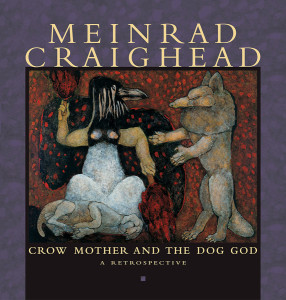 Meinrad Craighead has spent her long life creating images and words in her search for the deepest sources of the divine. As the girl christened Charlene Marie Craighead, she spent her summers in North Little Rock, Arkansas, running with packs of dogs, digging holes and listening to the stories of her beloved grandmother, “Memaw.” When she took holy orders as a Benedictine nun in England, she was given the name Meinrad, in honor of St. Meinrad, one of her own ancestors. Leaving the convent fourteen years later, she came to her heart’s home in New Mexico, where she has lived with dog companions and human friends ever since. In all that time, she has never stopped drawing, painting and writing about the images she has discovered.
Meinrad Craighead has spent her long life creating images and words in her search for the deepest sources of the divine. As the girl christened Charlene Marie Craighead, she spent her summers in North Little Rock, Arkansas, running with packs of dogs, digging holes and listening to the stories of her beloved grandmother, “Memaw.” When she took holy orders as a Benedictine nun in England, she was given the name Meinrad, in honor of St. Meinrad, one of her own ancestors. Leaving the convent fourteen years later, she came to her heart’s home in New Mexico, where she has lived with dog companions and human friends ever since. In all that time, she has never stopped drawing, painting and writing about the images she has discovered.
Crow Mother and the Dog God, a Retrospective covers more than forty years of the history of her work. It contains over three hundred pages of prints and text, accompanied by a chronology and an index.
Meinrad’s art encompasses a broad range of media and styles. She has worked on big canvases in charcoal, and on small rectangles of scratch board in ink. Some of her pieces could be called abstract, while others are surreal, or evoke primitive sacred art. Some have broad, sweeping strokes, full of powerful movement, others are finely detailed, even down to stillness. She has made prints using the back of a spoon instead of a press. For years, she abraded the surfaces of her scratch boards with sand paper and steel wool in a lengthy process that left fine swirls and grooves, which then caught her black and colored inks in intricate patterns. These pieces seem to glow and yet swarm with shadows. Finally, she wore out her shoulder, a sacrifice to her artistic vision and technique. Now she paints with watercolors, producing ghastly (in the oldest sense of the word), beautiful pieces in vivid colors and shapes that evoke the traditions of the land around her.
For Meinrad, the principle figures of the divine in her devotion have been the Black Madonnas of Europe — to whom she has made numerous pilgrimages — the Native American Crow Mother and the Dog God, Anubis. The Black Madonna and Crow Mother reach for her in an enveloping embrace, giving her life through cycles of earth, birth, milk, blood and death. The Dog God, also known as “the opener of the way,” calls her to the endless search. She finds them mediated for her in the land and animals around her, especially her deeply adored dogs, whom she has considered her guides into the sacred. She also sees them in her dreams, and in her memories of sacred experiences and her grandmother’s stories.
Images from her Catholic heritage, of Crow Mother, of Anubis, and also of Artemis — the huntress who truly sees the natural world — repeat over and over in Meinrad’s work. She relies on literal representations, but also symbols, patterns and colors that call up deep responses from the unconscious. She paints gardens, trees, the World Tree, flying bleeding women, wolves giving milk, dogs being buried and sprouting grass.
If one looks slowly through the hundreds of prints in Crow Mother and the Dog God, one gradually develops a sense of Meinrad’s understanding of the huge, waiting, watching, calling power she feels all around her. Her detailed pieces in particular teem with images and concepts from Catholic spirituality and ancient mythologies, blended in visceral lunges or relentless flows. If one reads the contemplative essays and poetry she has written to accompany her work, one can see more and more clearly that all art for Meinrad is prayer, a continual supplication for vision.
Others have also contributed written pieces to this book, their own reflections on Meinrad’s work. Rosemary Davies, once Meinrad’s fellow nun, writes as a friend, recounting her experience of watching Meinrad grow and live as an artist. Virginia Beane Rutter explores the feminine vision in Meinrad’s work, juxtaposing it with Jung’s psychological insights. Eugenia Parry talks at length about Meinrad’s deep connection to animals, and their significance in her thought and art.
Collectors of art books will find this volume to be a valuable addition to their collection. Beautifully compiled and produced, it presents the work of a brilliant artist. But others who are drawn to images from mythology, spirituality and folklore will also find themselves entranced. This book is, in many ways, an enormous prayer that anyone who will become open and watchful may enter.
(Pomegranate, 2003)
Meinrad Craighead has a Web site, wherein you can find information about the creative
and spiritual retreats she holds for women, images of her work, and ways to order prints.
